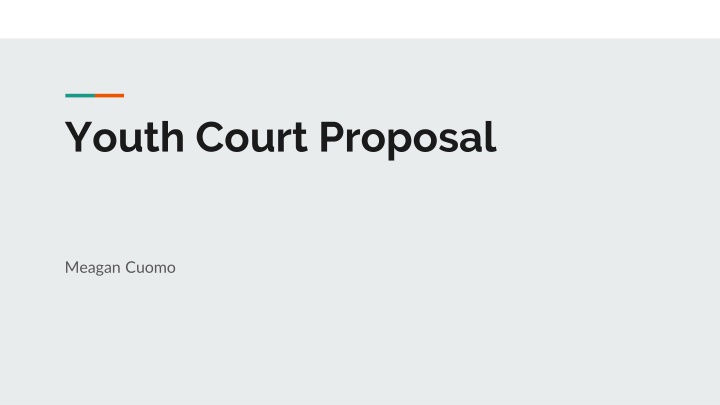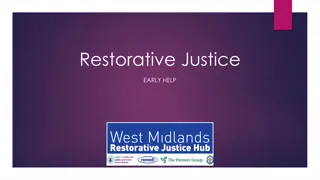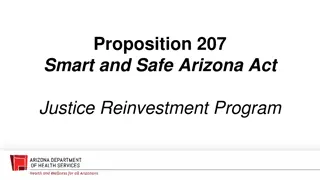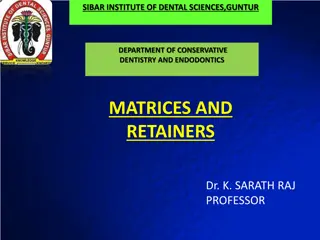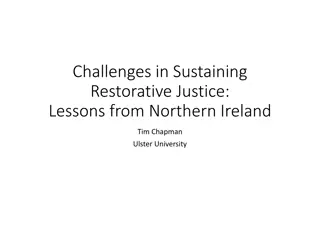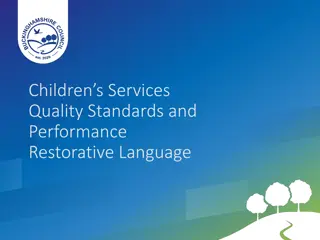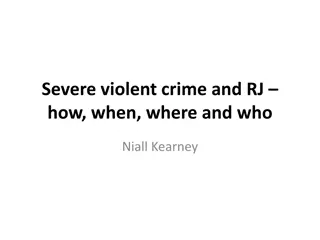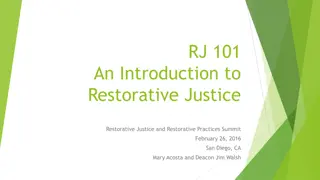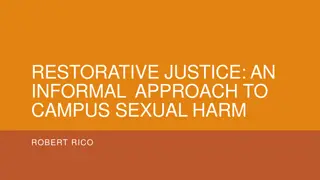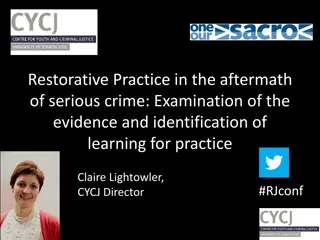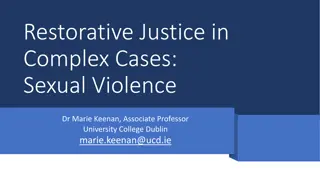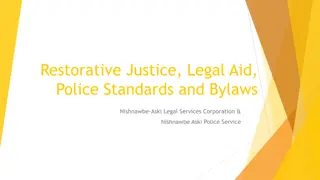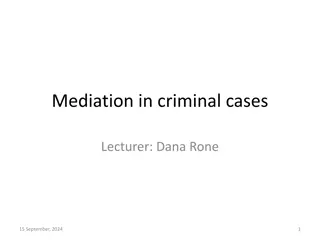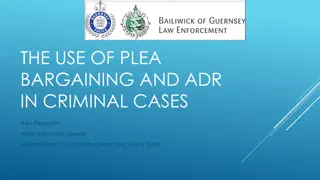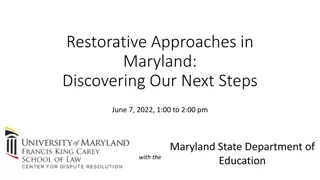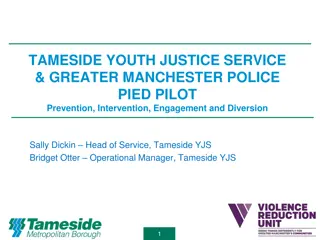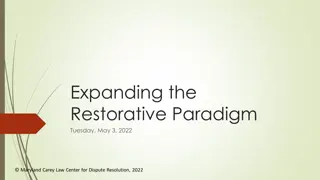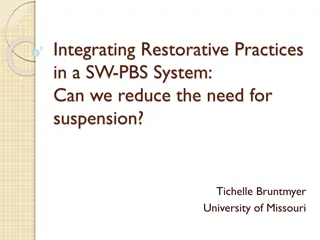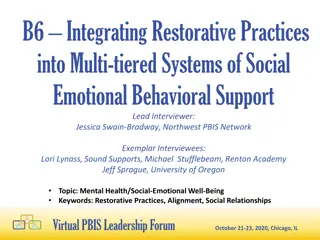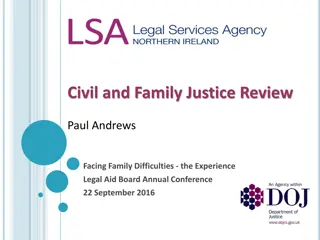Youth Court Proposal for Restorative Justice Program
Meagan Cuomo's Youth Court Proposal aims to offer a restorative justice alternative for nonviolent, first-time juvenile offenders, focusing on offenses like vandalism and truancy. The project involves research, community engagement, and creating connections with local schools to facilitate learning and growth among juveniles. Short-term goals include gaining community participation, while long-term goals target reducing recidivism and expanding the program to include internship opportunities. Key needs include a dedicated Youth Court Manager and support from various community stakeholders.
Download Presentation

Please find below an Image/Link to download the presentation.
The content on the website is provided AS IS for your information and personal use only. It may not be sold, licensed, or shared on other websites without obtaining consent from the author.If you encounter any issues during the download, it is possible that the publisher has removed the file from their server.
You are allowed to download the files provided on this website for personal or commercial use, subject to the condition that they are used lawfully. All files are the property of their respective owners.
The content on the website is provided AS IS for your information and personal use only. It may not be sold, licensed, or shared on other websites without obtaining consent from the author.
E N D
Presentation Transcript
Youth Court Proposal Meagan Cuomo
Purpose To provide a restorative justice alternative to the traditional juvenile justice process for nonviolent, first-time juvenile offenders Offenses: vandalism, petit larceny, truancy, status offenses, and other offenses of this nature
Context Honors CJ class about diversity in the CJ system Independent study project Consisted of: research, having conversations with various professionals, and visiting and observing the Youth Justice Program in Richmond, Virginia Spoke with an individual from the Office on Youth, as well as the director of the Richmond Youth Justice Program, and various community members
Short-Term Goals Gain community participation and acceptance of restorative justice programming Create connections with individuals who could aid in the life skills classes Find locations with Parks and Recreation to consistently hold youth court Create strong connections with the local schools for finding students to volunteer as courtroom players and finding candidates who would benefit from participating in the youth court as a respondent Create a positive environment from which juveniles can learn and grow both personally and professionally
Long-Term Goals Phase in other types of offenses, possibly including some violent crimes Create a program that people know about and view positively Create internship opportunities for college students to help run the program To see a reduction in recidivism for the target offenses To ease the burden placed on the traditional juvenile justice system To explore the addition of another part-time staff member for program support, if needed
Needs A dedicated individual to be a Youth Court Manager to run the program Access to community spaces to hold hearings and life skills courses Life skills course curriculum (ARISE) Support from the local Court Service Units, schools, law enforcement, and the community Funding to support program implementation, growth, and development
Stakeholders Staunton City Public Schools Augusta County Public Schools Waynesboro Public Schools Staunton City Police Department Augusta County Sheriff s Office Waynesboro City Police Department Parks and Recreation Mary Baldwin University Commonwealth Attorney s Office Office on Youth Court Services Unit
Program Structure Age 11-17 Offenses: vandalism, truancy, minor theft, status offenses (i.e. drinking underage, being out past curfew, smoking underage, etc.) and other typically nonviolent first time offenses Sanctions: writing an apology letter or a research paper, taking life skills classes (required for all participants), possibly restitution, and community service Referrals: Schools or guidance counselors in the schools Police departments Parents Court Services Unit
Program Structure: Tribunal Model One presiding judge, two advocate judges; all deliberate outcome of the case Youth Advocate - Answers any questions that the respondent has to make sure they understand the hearing process, their responsibilities, and their rights; gets the respondent s side of the story; makes sure the hearing is carried out in a fair manner (Volz & Saiyed, pp. 6-7, 2018) Bailiff - Maintains order within the courtroom; makes sure everything is happening in a timely and orderly fashion; makes sure everyone has the chance to speak; escorts the respondent out of the room if necessary (Volz & Saiyed, p. 8, 2018) Clerk - Maintains records and case paperwork for each hearing, ensures that all paperwork is given to the appropriate individuals and collected following each hearing (Volz & Saiyed, p. 6, 2018) Respondent - Gentler term for defendant; participates in the process by explaining their interpretation of the events and engaging in a dialogue with their peers Community Advocate Reads the facts of the case to the courtroom players and respondent
Promising Data Arizona: 9% recidivism rate for youth court vs 15% in the traditional juvenile justice process (Butts & Ortiz, 2011) Blount County, Tennessee: Less than 1% of participants reoffend vs 22-26% in the traditional juvenile justice process (Blount County Youth Court, 2021) Anne Arundel County, Maryland: 11% recidivism rate for participants, with 82% completion rate (Teen Court: Anne Arundel County, MD, 2020) Stark County, Ohio: 15% recidivism rate for youth who have completed the program (Woods, 2019) Colorado Springs, Colorado: 7% recidivism rate with over 90% program completion rate (Teen Court, 2023) Comanche County, Oklahoma: 95% of participants do not reoffend - Established in 1991 (Comanche County Teen Court, 2023) Maryland: recidivism rates for participants measured at 6 months and 12 months after program completion were significantly lower than rates for youth who did not participate in the program (Bright, et al, 2013) Chester, Pennsylvania: more than 75% of respondents did not commit multiple disciplinary offenses after their youth court hearing and participation (Norton, Gold, & Peralta, 2013) Missouri: 9% recidivism rate for youth court vs 27% in the traditional juvenile justice process (Butts & Ortiz, 2011)
Community Engagement Community spaces would need to be accessed to hold hearings for the youth court. These spaces would be accessed and reserved through local Parks and Recreation agencies. Local agencies could be partners in community service, such as local nonprofits, churches, food banks, etc. This would provide excellent volunteering experience for the youth involved, as well as be beneficial to the agencies who choose to participate. Life skills classes would be a requirement for all respondents who participate in the youth court program. An excellent addition to these classes would be guest speakers from the community who could speak to the youth about certain topics, such as drug use, vaping, peer pressure, etc. Local youth could volunteer to be the courtroom players in the youth court, giving them exposure to this field, as well as volunteer experience.
Opportunities The opportunity for juvenile offenders to learn life skills and not be prosecuted in the traditional justice system The opportunity for youth within the community to learn how the court system works, specifically individuals who have shown leadership potential, and to enhance their social skills The opportunity for youth to be inspired to go into law or criminal justice-related fields following high school graduation The opportunity for the community to learn about restorative justice opportunities, possibly leading to more reform within the traditional justice system, if successful Increased understanding of procedural justice, which may influence perceptions of the fairness of the local criminal justice system
Funding The Youth Court Manager would require compensation, with a proposed salary of $45,000. This will encompass the following duties: Collaborating with stakeholders Recruiting and training volunteers Teaching and connecting with individuals to teach life skills classes Overseeing youth court sessions Evaluating success of the program and following up with youth who have completed the program
Funding $1,000 for life skills curriculum (ARISE Juvenile Offender Rehabilitation Program) A budget of about $2,000: printing materials for the youth, purchasing any technological necessities, and purchasing snacks and art supplies to make the youth feel comfortable and cared for (Richmond Youth Justice) Where? Virginia Department of Criminal Justice Services (DCJS) Commonwealth Attorney s Office VJCCCA Restorative Justice Program - Programs that provide youth an opportunity to repair harm caused by their behavior and to recognize how their behavior impacts others; May also include restitution and/or other compensation to victims (VJCCCA, 2021) Local school system contributions Donations
Theoretical Support Labeling theory: When people are labeled, they conform to these labels, whether positive or negative. Negative labels can lead to stigmatization, and an individual may accept the labels rather than trying to prove them wrong or change their ways (Skaggs, 2023). With youth, this is a crucial criminological theory. Kids are often labeled good or bad, and youth can conform to these labels, which can often cause bad behaviors to worsen, sometimes leading to delinquent or criminal activities. Social bond theory: Individuals have a strong social influence on their same-age peers (Wickert, 2022). This is especially applicable to adolescents, who tend to have an extremely strong influence on one another. This can apply either positively or negatively. When peers have a negative influence on one another, it can lead to deviance. Alternatively, a positive peer influence can lead to reform and change in one s behaviors, as is the idea behind a youth court. Social learning theory: This theory stresses the importance of observing and learning behaviors from others, both positive and negative (Mcleod, 2023). When behaviors are learned through others, people tend to become conditioned into applying these behaviors and patterns into their own lives. A youth court would provide positive mentors and role models, as well as skills and behaviors, for youth to learn and apply to their own lives.
Conclusion Reduce recidivism rates Create volunteer opportunities Enhance the social skills of youth Teach valuable life skills
